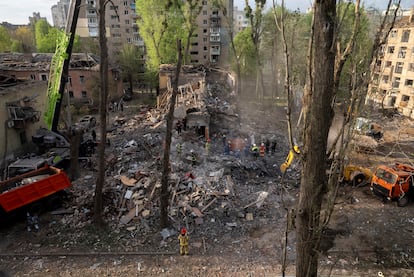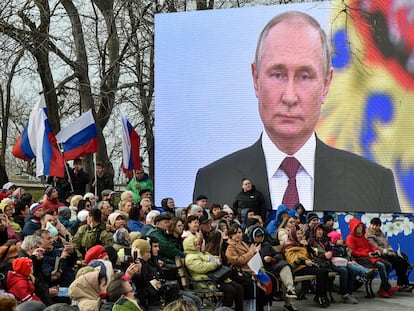Russian drone and missile strikes leave nine dead in Kyiv in worst attack on Ukrainian capital since summer
Volodymyr Zelenskiy cuts trip to South Africa short and insists on intensifying ‘diplomatic efforts’ to reach a ceasefire


Daily attacks and deaths in Ukraine are a harsh reality in the face of the lack of clarity in the indirect negotiations between Moscow and Kyiv, which provide no light at the end of the tunnel despite pressure from the United States. A wave of more than 200 Russian drones and missiles hit a dozen regions of Ukraine throughout the early hours of Thursday morning. The worst-hit was Kyiv, which suffered the largest attack on the capital since last summer. The death toll so far is nine with more than 60 wounded, including six children and a pregnant woman, according to municipal, military, and government authorities. President Volodymyr Zelenskiy has announced that he will cut short his trip to South Africa due to the crisis in his country and has insisted that “diplomatic efforts” be intensified to reach a ceasefire.
The search for missing people is still ongoing among the wreckage of buildings hit in various districts of the city. Wounded people and bodies have been recovered amid fires and collapses of apartment buildings, vehicles, garages, and commercial premises. “Russian peace in all its splendor,” Tymur Tkachenko, head of the Kyiv military administration, summed up in a statement posted on the social network Telegram, urging the population to remain in bomb shelters.
As if from the scene of an earthquake, emergency teams have managed to extract some survivors from the piles of rubble that some buildings have been transformed into and among which cell phones ring occasionally, as witnessed in images shown by local media. The air strikes have caused destruction and casualties in up to 13 locations in Kyiv, where rescuers assisted by dogs are racing against the clock to try to find more trapped people while police officers search for residents among the affected buildings.
In the Sviatoshynskyi neighborhood, the hardest hit, Lyudmyla Ryabovol sits on a chair in the middle of the street, now in daylight, next to the blanket-covered body of her 84-year-old mother, Olena Lunivna. “She was old, but not yet dead,” she sighs, speaking to a camera. In addition to Kyiv and its surrounding areas, the attack hit Kharkiv, the country’s second-largest city, as well as the regions of Yitomir, Zaporizhzhia, Dnipropetrovsk, Poltava, Sumy, and Khmelnytskyi. Damage has also affected rail infrastructure, although trains continue to run normally.
The attack occurred while Zelenskiy was visiting South Africa, where he met with his counterpart, Cyril Ramaphosa. The president has reduced his schedule to return to Ukraine as soon as possible. Zelenskiy was decisive Wednesday in refusing to accept Kyiv’s legal recognition of the Crimean peninsula as Russian territory, as demanded in the proposal put forward by the administration of U.S. President Donald Trump.
The Republican leader insists that Crimea “was lost years ago” and that its ownership isn’t even part of the current discussions, according to a statement on social media. Trump asserted Wednesday that he already has an agreement with Russia to end the war, although Kyiv’s approval is still lacking, which he said is “so difficult” to achieve, expressing his frustration with Zelenskiy for not accepting Washington’s proposed plan, which clearly benefits Moscow.
“It has been 44 days since Ukraine agreed to a full ceasefire and a halt to strikes. This was a proposal from the United States. And it has been 44 days of Russia continuing to kill our people and evading tough pressure and accountability for its actions,” Zelensky lamented in a statement on X.
“Yesterday’s Russian maximalist demands for Ukraine to withdraw from its regions, combined with these brutal strikes, show that Russia, not Ukraine, is the obstacle to peace. Moscow, not Kyiv, is where pressure should be applied,” wrote Ukrainian Foreign Minister Andrii Sybiha in a post on his X profile. “Putin demonstrates through his actions, not words, that he does not respect any peace efforts and only wants to continue the war,” added Sybiha, who remains in South Africa pursuing the agenda that Zelenskiy has cut short.
Russian authorities, for their part, accuse Zelenskiy of scuppering diplomatic efforts by refusing to formalize the occupation of Crimea. Foreign Ministry spokeswoman Maria Zakharova believes the Ukrainian president lacks the capacity to negotiate an agreement that would end the war, Reuters reports.
Russia launched the intense bombardment hours after a high-level delegation from the Ukrainian government, which included Sybiha himself, traveled to London to continue exploring a ceasefire, along with representatives from the United Kingdom, France, Germany, and the United States. The latter delegation arrived in a rather lax manner at the last minute, in the absence of Secretary of State Marco Rubio or Trump’s special envoy, Steve Witkoff, suggesting Washington viewed the meeting as immaterial: not as significant, at least, as Witkoff’s planned visit to Russia this Friday to meet with Russian President Vladimir Putin.
On the other side, Kremlin authorities denounced, without reporting casualties, the destruction of 87 Ukrainian drones, more than half of them — up to 45 — launched over the Crimean peninsula, a Ukrainian territory illegally annexed by Moscow in 2014. Hours earlier, Ukrainian authorities had admitted — and celebrated — having managed to strike a factory capable of producing 300 drones a day in the town of Yelabuga, over 600 miles from the border between the two countries.
Sign up for our weekly newsletter to get more English-language news coverage from EL PAÍS USA Edition
Tu suscripción se está usando en otro dispositivo
¿Quieres añadir otro usuario a tu suscripción?
Si continúas leyendo en este dispositivo, no se podrá leer en el otro.
FlechaTu suscripción se está usando en otro dispositivo y solo puedes acceder a EL PAÍS desde un dispositivo a la vez.
Si quieres compartir tu cuenta, cambia tu suscripción a la modalidad Premium, así podrás añadir otro usuario. Cada uno accederá con su propia cuenta de email, lo que os permitirá personalizar vuestra experiencia en EL PAÍS.
¿Tienes una suscripción de empresa? Accede aquí para contratar más cuentas.
En el caso de no saber quién está usando tu cuenta, te recomendamos cambiar tu contraseña aquí.
Si decides continuar compartiendo tu cuenta, este mensaje se mostrará en tu dispositivo y en el de la otra persona que está usando tu cuenta de forma indefinida, afectando a tu experiencia de lectura. Puedes consultar aquí los términos y condiciones de la suscripción digital.

